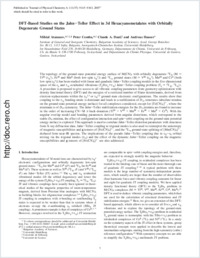DFT-based studies on the Jahn-Teller effect in 3D hexacyanometalates with orbitally degenerate ground states
- Atanasov, Mihail Institute of General and Inorganic Chemistry, Bulgarian Academy of Sciences, Sofia, Bulgaria
- Comba, Peter Anorganisch-Chemisches Institut, Universität Heidelberg, Germany
- Daul, Claude Department of Chemistry, University of Fribourg, Switzerland
- Hauser, Andreas Département de Chimie Physique, Université de Genève, Switzerland
-
24.08.2007
Published in:
- The Journal of Physical Chemistry A. - 2007, vol. 111, no. 37, p. 9145 -9163
English
The topology of the ground-state potential energy surface of M(CN)₆ with orbitally degenerate ²T2g (M = TiIII (t2g¹), FeIII and MnII (both low-spin t2g⁵)) and ³T1g ground states (M = VIII (t2g²), MnIII and CrII (both low-spin t2g⁴)) has been studied with linear and quadratic Jahn-Teller coupling models in the five-dimensional space of the εg and θ2g octahedral vibrations (Tg⊗(εg+θ2g) Jahn-Teller coupling problem (Tg = ²T2g, ³T1g)). A procedure is proposed to give access to all vibronic coupling parameters from geometry optimization with density functional theory (DFT) and the energies of a restricted number of Slater determinants, derived from electron replacements within the t2g 1,5 or t2g2,4 ground-state electronic configurations. The results show that coupling to the θ2g bending mode is dominant and leads to a stabilization of D₃d structures (absolute minima on the ground-state potential energy surface) for all complexes considered, except for [Ti(CN)₆]³⁻, where the minimum is of D₄ h symmetry. The Jahn-Teller stabilization energies for the D₃d minima are found to increase in the order of increasing CN-M π back-donation (TiIII< VIII< MnIII< FeIII< MnII< CrII). With the angular overlap model and bonding parameters derived from angular distortions, which correspond to the stable D₃d minima, the effect of configuration interaction and spin-orbit coupling on the ground-state potential energy surface is explored. This approach is used to correlate Jahn-Teller distortion parameters with structures from X-ray diffraction data. Jahn-Teller coupling to trigonal modes is also used to reinterpret the anisotropy of magnetic susceptibilities and g tensors of [Fe(CN)₆]³⁻, and the ³T1g ground-state splitting of [Mn(CN)₆]³⁻, deduced from near-IR spectra. The implications of the pseudo Jahn- Teller coupling due to t2g-eg orbital mixing via the trigonal modes (θ2g) and the effect of the dynamic Jahn-Teller coupling on the magnetic susceptibilities and g tensors of [Fe(CN)₆]³⁻ are also addressed.
- Faculty
- Faculté des sciences et de médecine
- Department
- Département de Chimie
- Language
-
- English
- Classification
- Chemistry
- License
-
License undefined
- Identifiers
-
- RERO DOC 8588
- DOI 10.1021/jp0731912
- Persistent URL
- https://folia.unifr.ch/unifr/documents/300608
Statistics
Document views: 146
File downloads:
- pdf: 262
